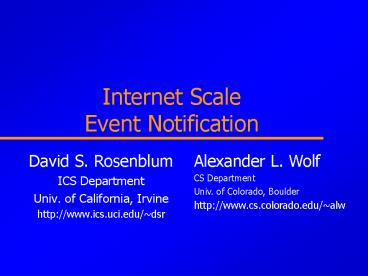Internet Scale Event Notification - PowerPoint PPT Presentation
1 / 25
Title:
Internet Scale Event Notification
Description:
(Politecnico di Milano and UC Irvine) Some Statistics from. Network Wizards ... SIENA. Event service architectures. JEDI. Object-oriented event service for Java ... – PowerPoint PPT presentation
Number of Views:16
Avg rating:3.0/5.0
Title: Internet Scale Event Notification
1
Internet ScaleEvent Notification
- David S. Rosenblum
- ICS Department
- Univ. of California, Irvine
- http//www.ics.uci.edu/dsr
Alexander L. Wolf CS Department Univ. of
Colorado, Boulder http//www.cs.colorado.edu/alw
2
Acknowledgment
- Antonio Carzaniga(Politecnico di Milano and CU
Boulder) - Dennis Heimbigner(CU Boulder)
- Elisabetta Di Nitto(CEFRIEL and UC Irvine)
- Alfonso Fuggetta(Politecnico di Milano and UC
Irvine)
3
Some Statistics fromNetwork Wizards (www.nw.com)
- January 1998 Survey
- 29,669,611 hosts in DNS
- 5,331,640 of these reply to ping
- 204 active level 1 domains
- 781,602 level 2 domains
- 10,380,858 level 3 domains
- These are double the January 1997 survey numbers
4
Attributes of Internet Scale
- Huge numbers of hosts and users
- Vast numbers of events
- Heterogeneity
- Increased importance of
- Network latency
- Autonomy
- Resource accounting
- Security
- Mobility
5
Implications of Internet Scale on Event
Notification
- Event interaction becomes too burdensome for
applications to manage on their own - Thus, a separate event notification service is
required - But, event technologies originally designed for
LANs dont scale
6
What An Event Is Not
Common notions of event confound the
phenomenon, the representation, and the transport
of an event
- An event is not
- an object
- a message
- a notification
7
What Is an Event?
Object of Interest
8
What Is an Event?
Object of Interest
Invoker
9
What Is an Event?
Object of Interest
Invoker
invocation
10
What Is an Event?
- An event is the effect of the termination of an
invocation of an operation on some object of
interest
Object of Interest
Invoker
invocation
11
What Is an Event?
- An event is the effect of the termination of an
invocation of an operation on some object of
interest - Events occur regardless of whether or not theyre
observed
Object of Interest
Invoker
invocation
12
Event Notification
Interested Party
Event!
Object of Interest
Interested Party
13
Event Notification
Interested Party
Object of Interest
Interested Party
14
Event Notification Protocol
Interested Party
Object of Interest
15
Event Notification Protocol
Interested Party
Advertise
Object of Interest
16
Event Notification Protocol
Subscribe
Interested Party
Advertise
Object of Interest
17
Event Notification Protocol
Subscribe
Interested Party
Advertise
Object of Interest
Publish
18
Event Notification Protocol
Subscribe
Interested Party
Notify
Advertise
Object of Interest
Publish
19
Event Notification Protocol
Subscribe
Interested Party
Notify
Unsubscribe
Advertise
Object of Interest
Publish
Unadvertise
20
Event Notification Infrastructure
Interested Party
Object of Interest
- Provides
- Storage of advertisements
- Storage of subscriptions
- Efficient delivery of notifications
21
Service Protocol Infrastructure
- Protocol developers exploit existing
infrastructures - e.g., new protocols exploiting Web servers
- Infrastructure providers must design a protocol
- e.g., CORBA Event Service based on RPC
- e.g., TIBCO based on publish/subscribe
22
Other Critical Issues (I)
- Event observation
- Polling vs. announcing
- Extraction of event information
- Event naming
- Structure-based vs. content-based
- Pattern-matching and filtering
- Expressive power vs. efficiency
23
Other Critical Issues (II)
- Time ordering
- Relativistic effects
- Availability of global clock
- Resource accounting
- Allocation of service costs
- Mobility of objects of interest and interested
parties - Efficient reconfiguration of service
24
Conclusions
- Current technologies are optimized for special
cases - A single generator of events
- e.g., PointCast
- Event notification as a component of a single
application - e.g., CORBA Event Service
- Need better evaluation criteria
- Model problems, benchmarks, metrics,
25
Additional Pointers
- Design Framework
- Rosenblum Wolf, A Design Framework for
Internet-Scale Event Observation and
Notification, Proc. ESEC/FSE 97, Springer LNCS
1301 - SIENA
- Event service architectures
- JEDI
- Object-oriented event service for Java































